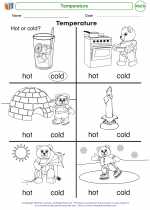Temperature
Temperature is a measure of how hot or cold something is. It is a fundamental concept in science and is used in everyday life to describe our environment. In the context of weather, temperature is a crucial factor that determines the conditions outside. In the study of materials, temperature affects their properties and behavior.
Units of Temperature
Temperature is commonly measured in degrees Celsius (°C) or degrees Fahrenheit (°F). In scientific contexts, the Kelvin (K) scale is also used. The Celsius and Fahrenheit scales are based on the freezing and boiling points of water, with 0°C and 32°F being the freezing point and 100°C and 212°F being the boiling point. The Kelvin scale starts at absolute zero, the lowest possible temperature, which is equivalent to -273.15°C.
Measuring Temperature
Temperature can be measured using various instruments, such as thermometers. These devices contain a temperature-sensitive element, such as mercury or a digital sensor, which expands or contracts in response to temperature changes. The reading on the thermometer indicates the current temperature.
Effects of Temperature
Temperature has a significant impact on the physical and chemical properties of substances. For example, changes in temperature can cause materials to expand or contract, change phase (e.g., from solid to liquid), or undergo chemical reactions. In living organisms, temperature plays a critical role in metabolic processes and overall health.
Temperature Scales Conversion
Converting between different temperature scales involves using specific conversion formulas. For example, to convert from Celsius to Fahrenheit, you can use the formula °F = (°C × 9/5) + 32. To convert from Celsius to Kelvin, you can use the formula K = °C + 273.15.
Understanding temperature is important for a wide range of applications, from cooking and maintaining comfort in indoor environments to scientific research and technological development.


